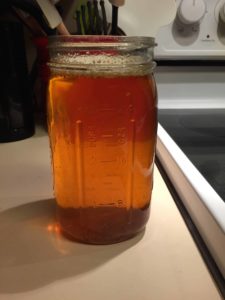Written by Avance Care registered dietitian Chris Thompson, MS, RDN, LDN
What is Ghee?
Ghee has long been a component of Ayurveda, one of the world’s oldest whole-body healing practices focusing on achieving balance between mind, body, and spirit. It plays a prominent role as a cooking oil in kitchens practicing various forms of holistic health. Ghee has been in millions of home kitchens for years and is now quickly gaining traction in new kitchens as a replacement for butter, olive oil, avocado oil, any cooking other cooking fat or oil, or added at the end of cooking for extra flavor. Ghee is ultimately a product of butter.
Butter, clarified butter, and ghee. What are the differences?
Butter contains water, fat, and milk solids (milk solids are the very small amounts of proteins, sugars, and minerals found in butter, and water. Clarified butter is only the milk fat after water has evaporated out and milk solids have separated and been strained from the milk fat. There is one crucial difference between clarified butter and ghee: with ghee, milk solids are caramelized prior to removal and add a nutty flavor to the milk fat. This results in an intoxicating, homey, and rich smell permeating throughout households all over the world.
How is ghee made and used?
To make ghee, put a sauce pan on low heat and place 1 cup or so of butter in it. I prefer using unsalted butter for a smoother resulting texture. Let the butter melt slowly and cook for about 10-20 minutes, time varies depending on the pan and stove. As the butter cooks, a white foam will form on top and creamy bubbles start to pop on the surface. This is the water evaporating out of the butter. The foam will soon disappear and a second foam will form shortly thereafter. At this point, the ghee is nearly complete and should be watched carefully. You’ll soon notice milk solids separating from the milk fat – occasionally stir and scrape the bottom of the pan to prevent these solids from burning. The ghee is done when milk solids are golden brown and the nutty smell starts to circulate throughout the kitchen. Let it cool and strain through a cheese cloth to remove all milk solids. Personally, I pour my ghee straight into a mason jar, let it rest, then tap the sides of the jar to help the milk solids fall to the bottom. I just throw out the last little bit when I reach the bottom of the jar. Here’s a picture of my latest batch, all golden brown and delicious.

Ghee can be kept at room temperature for up to a month or in the fridge for up to four months.¹ Ghee can also be infused with onions, garlic, or even foraged ramps (kind of a wild onion garlic hybrid). Infused ghee needs to be refrigerated and will spoil much faster than plain ghee.
No time.. no problem. All major grocers carry ghee. Look near other cooking oils in the baking and the international isles.
Ghee is very stable at high heat (450° F) making it perfect for sautéing and oven roasting at higher temperatures. It’s also great for enriching dishes at the end of cooking. However, it is a pure fat primarily of the saturated variety – more on that below.
Should I use ghee as my primary cooking fat/oil?
Setting aside ghee’s rich history in holistic health, the science is lacking on its impact on human subjects. Ghee is primarily a saturated fat. The American Heart Association recommends a dietary pattern that achieves 5-6% of calories from saturated fat as higher amounts may raise cholesterol levels and impact our lipid profiles.²
The research on ghee is also lacking. Some studies have been conducted on various breeds of rats that serve as models for the general population and populations genetically predisposed to disease. The rats serving as a model for the general population did not see a significant change in cholesterol and triglycerides when fed 5% and 10% ghee-supplemented diets. However, the rats serving as a model for those of us genetically predisposed to disease showed an increase in total cholesterol and triglycerides when fed a 10% ghee-supplemented diet.³ At this time, studies on human subjects are limited and inconclusive.
What do I do?
At the end of the day, ghee is a saturated fat and should be treated as such. Use it like butter – sparingly. I’d really limit and even avoid it if there is a family history and genetic predisposition for high cholesterol and heart disease.
Talk to your Avance Care Registered Dietitian to navigate through the foam and clarify any questions you may have about the role of ghee in your diet.
“You put water into a cup.. it becomes the cup,
You put water into a bottle.. it becomes the bottle,
Now water can flow.. and water can crash,
Be water my friend”
– Bruce Lee
1) https://www.cookinglight.com/cooking-101/essential-ingredients/what-is-ghee
2) https://www.heart.org/en/healthy-living/healthy-eating/eat-smart/fats/saturated-fats
3) https://www.ncbi.nlm.nih.gov/pmc/articles/PMC3215354/
Chris is a Registered Dietitian at Avance Care’s Apex and Holly Springs locations. He loves experimenting in the kitchen, staying active, playing and watching sports, spending quality time with his two dogs, and reading Muhammad Ali quotes.
